Sublime sublimation
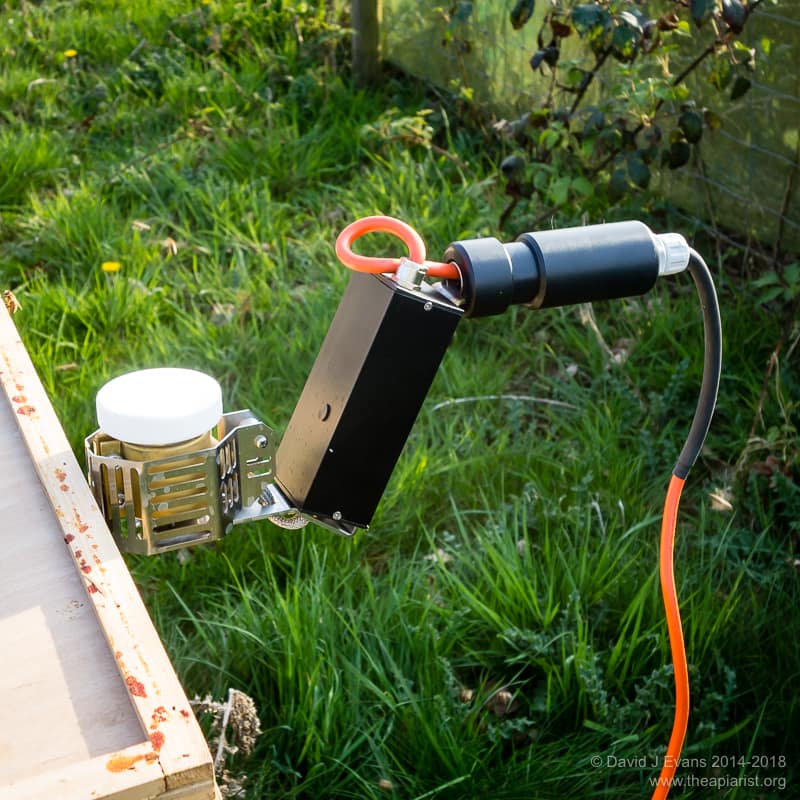
Sublimox vaporiser …
Sublimation is the conversion of a substance in the solid phase into the gas phase without going via the intermediate liquid phase. With suitable heating oxalic acid (OA) powder can be converted into a vapour which, when spread through the hive, provides a quick and effective way to reduce the mite levels … hence it’s often referred to as oxalic acid vaporisation (or vaporization … if you search the web on this topic you’ll find at least four variant spellings). With too much heating OA decomposes to formic acid and carbon monoxide, so the temperature of the vaporiser is critical to generate the optimal cloud of OA vapour (or vapor!). I’ve been using a Sublimox vaporiser this season with good results and provide a description of the machine and its use here.
Vaporisation vs dribbling
Most beekeepers are familiar with midwinter treatment with 3.2% OA solution (in syrup), applied by ‘dribbling‘ 5ml per seam across the clustered colony. Under these conditions the colony needs to be broodless as a) it’s not effective against mites in capped cells and b) the OA dissolved in syrup is toxic to brood. It’s also reported that the ingested OA may be suppress subsequent brood rearing, at precisely the time the colony should be getting started for the upcoming season. Vaporisation or sublimation avoids this toxicity … the OA is introduced to the hive as a gas which permeates the entire colony, recrystallising as tiny crystals on all surfaces – bees, comb, internal walls etc. Studies of OA vaporisation has shown it is ~95% effective in reducing phoretic mite numbers. I recommend you read the extensive coverage by Randy Oliver @ Scientific Beekeeping who covers efficacy, mode of action and toxicity (though I’ll return to this last bit later).
Sublimox vaporiser
This is an active vaporiser which blows a jet of vaporised OA through a small (8mm) nozzle. The machine consists of a handle, a box of electrickery (which I’ve not opened) and a heating pan surrounded with a safety guard. The machine is rated at 230V AC and 300W so you need either a car battery and inverter or a suitable generator (which is what I use). The vaporiser is simplicity itself to use. One gram of OA powder is placed into a small plastic ‘cup’, the preheated vaporiser is inverted and the ‘cup’ engaged with the heating pan. The nozzle is pushed through a hole in the hive body and the vaporiser is inverted again (so it’s now the correct way up – see the top photo on this page). The OA drops into the heating cup, immediately vaporises and is blown through the nozzle into the hive. It takes 40-50 seconds to use all the OA, at which point you can move on to the next hive.
This video shows the effect of dropping a few millilitres of water into the heating pan … it’s almost exactly the same when using OA, but less likely to cover my camera with a fine dusting of OA crystals 😉
Preparing the hive
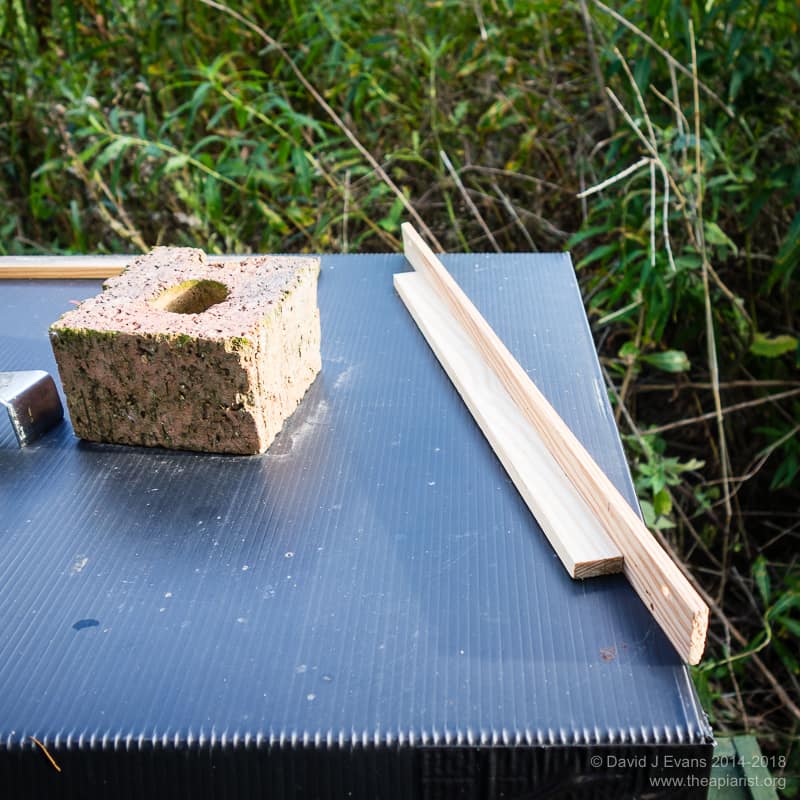
Entrance block …
To fill the hive with vaporised OA it’s important that as little as possible leaks out during the short period of treatment. I use a Correx Varroa tray underneath the open mesh floor. In addition, the kewl floors I use are easy to block using a simple L-shaped piece of softwood (I use these when transporting hives; when screwed onto the front of the floor there’s no danger of bees escaping). Part of the beauty of OA vaporisation is that the hive does not even need to be opened. I’ve drilled 9mm holes just above the open mesh floor level, through either the side or back of my floors. This is a better location to insert the nozzle of the Sublimox as there’s space under the frames to allow the gas to spread evenly and quickly throughout the hive. This is easier than the alternatives of using an eke with a suitable hole in it, or drilling through the side wall of the brood box (this is too close to the frames and you get poor spread of the gas – I’ve tried this on hives with a perspex crown board and it’s very obvious).
- Sublimox vaporiser
- Electrickery …
- Sublimox in use …
With a standard floor you could use a simple entrance block with a suitable hole in it. The nozzle gets hot … keep it away from poly hives or nucs! I treat my Everynuc poly nucs directly through the (cavernous) front entrance which I block using a thick piece of wood with a 9mm hole through the middle.
Preparing the beekeeper
OA vapour is pretty unpleasant and causes significant irritation to the eyes and lungs if exposed. Take care. You will need suitable eye protection and a mask of some sort. I use standard (and very inexpensive) safety goggles and a 3M dust/mist mask. You should also wear gloves when handling OA. It’s also wise to stand upwind of colonies being treated and to take care not to breath in any OA vapour that leaks out of gaps in the hive.
In use
I’ve treated four swarms this year using OA vaporisation. Three had very low mite levels, but the small churchyard swarm dropped several hundred mites in the 2-3 days following treatment. I don’t routinely count the mite drop on each day post treatment (I have a life) but have noticed it can increase over the first 2-3 days and then tails off over the following week or so. In large scale studies in Europe 95% efficacy was reported with mite drop continuing for up to a fortnight. There are a number of useful references on the Scientific Beekeeping site if you want to follow this up further.
- Inserted inverted …
- Generator …
- There goes a few pence …
I’ve also used OA vaporisation on almost all my colonies this autumn, instead of Apiguard treatment. If the colony has sealed brood the usual estimate is that at least 80% of the mites are occupying capped cells. These mites are unaffected by OA vaporisation (until they emerge) and it is therefore necessary to perform repeat treatments. Taking account of the life cycle of the mite and empirical measurements made by Hivemaker reported on the Beekeeping Forum, three treatments at five day intervals are required to have the maximum effect. Ideally this should be on a day or at a time when most of the colony is ‘at home’ … though the crystallised OA continues to be effective for several days after initial treatment. Fortunately, OA vaporisation has little or no effect on the queen, unlike many other mite treatments. The colony gets mildly agitated during treatment but calms down again within minutes and resumes foraging. In the colonies I’ve looked at after treatment there appears to be no gap in egg laying (I’ve also treated casts with virgin queens that have gone on to mate successfully). This is ideal for the autumn treatment when you want the colony to raise as many bees for overwintering as possible. In contrast, Apiguard regularly stops the queen from laying.
And finally …
There are other OA vaporisers made, and instructions on the web for a variety of DIY items – some looking more dangerous (to the operator, not the mite) than others. The majority of these are passive vaporisers, in which the OA is placed in a cool heating pan which is then placed on the floor of the colony and heated up. I’ve not used this type. They have the advantage of being less expensive and only require a 12V supply. However, they are slower to use as the pan takes longer to heat up and then needs to be cooled in a bucket of water between applications. They are also incompatible with the kewl floors I use and I presume – depending on how hot they get – with poly hives and nucs. I think the efficacy of the two types is supposed to be broadly similar.
I listened to Bob Smith talk at the MSWCC conference last week on shook swarms. I sat there thinking that a shook swarm followed shortly afterwards by a single shot of OA vapour would give a colony a really good opportunity to build up well, free of pathogens that have accumulated in the comb and free of the majority of phoretic mites and their viral payload.
Economics
The Sublimox vaporiser is not inexpensive. It costs about €380 from Icko Apiculture. This is a lot, but is about the same as three 3kg tubs of Apiguard (C. Wynn Jones list this at £87 a tub at the time of writing) which is enough to treat 90 colonies with two treatments per colony. In contrast, OA dihydrate powder in bulk (not from Thorne’s) is about £20 for 5kg … enough for 1250 colonies (assuming 4 treatments per colony – 3 doses in the autumn and one midwinter). For beekeeping associations, particularly those with large shared apiaries when treatments could and should – see a later post – be coordinated, it might be a very good investment.

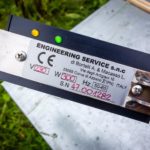
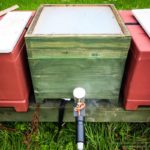

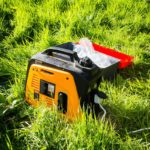

Join the discussion ...